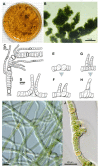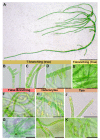Symphyonema bifilamentata sp. nov., the Right Fischerella ambigua 108b: Half a Decade of Research on Taxonomy and Bioactive Compounds in New Light
- PMID: 33918311
- PMCID: PMC8065813
- DOI: 10.3390/microorganisms9040745
Symphyonema bifilamentata sp. nov., the Right Fischerella ambigua 108b: Half a Decade of Research on Taxonomy and Bioactive Compounds in New Light
Abstract
Since 1965 a cyanobacterial strain termed 'Fischerella ambigua 108b' was the object of several studies investigating its potential as a resource for new bioactive compounds in several European institutes. Over decades these investigations uncovered several unique small molecules and their respective biosynthetic pathways, including the polychlorinated triphenyls of the ambigol family and the tjipanazoles. However, the true taxonomic character of the producing strain remained concealed until now. Applying a polyphasic approach considering the phylogenetic position based on the 16S rRNA and the protein coding gene rbcLX, secondary structures and morphological features, we present the strain 'Fischerella ambigua 108b' as Symphyonema bifilamentata sp. nov. 97.28. Although there is the type species (holotype) S. sinense C.-C. Jao 1944 there is no authentic living strain or material for genetic analyses for the genus Symphyonema available. Thus we suggest and provide an epitypification of S. bifilamentata sp. nov. 97.28 as a valid reference for the genus Symphyonema. Its affiliation to the family Symphyonemataceae sheds not only new light on this rare taxon but also on the classes of bioactive metabolites of these heterocytous and true-branching cyanobacteria which we report here. We show conclusively that the literature on the isolation of bioactive products from this organism provides further support for a clear distinction between the secondary metabolism of Symphyonema bifilamentata sp. nov. 97.28 compared to related and other taxa, pointing to the assignment of this organism into a separate genus.
Keywords: Fischerella; Symphyonema; ambigol; heterocytes; polyphasic approach; true-branching.
Conflict of interest statement
The authors declare no conflict of interest.
Figures





Similar articles
-
Halogenation-Guided Chemical Screening Provides Insight into Tjipanazole Biosynthesis by the Cyanobacterium Fischerella ambigua.Chembiochem. 2020 Aug 3;21(15):2170-2177. doi: 10.1002/cbic.202000025. Epub 2020 Apr 16. Chembiochem. 2020. PMID: 32182403 Free PMC article.
-
Ambigols from the Cyanobacterium Fischerella ambigua Increase Prodigiosin Production in Serratia spp.ACS Chem Biol. 2020 Nov 20;15(11):2929-2936. doi: 10.1021/acschembio.0c00554. Epub 2020 Nov 4. ACS Chem Biol. 2020. PMID: 33143417
-
Reptodigitus Chapmanii (Nostocales, Hapalosiphonaceae) Gen. Nov.: A Unique Nostocalean (Cyanobacteria) Genus Based on a Polyphasic Approach1.J Phycol. 2020 Apr;56(2):425-436. doi: 10.1111/jpy.12954. Epub 2020 Jan 9. J Phycol. 2020. PMID: 31837017
-
Peptoniphilus nemausensis sp. nov. A new Gram-positive anaerobic coccus isolated from human clinical samples, an emendated description of the genus Peptoniphilus and an evaluation of the taxonomic status of Peptoniphilus species with not validly published names.Syst Appl Microbiol. 2021 Sep;44(5):126235. doi: 10.1016/j.syapm.2021.126235. Epub 2021 Jul 17. Syst Appl Microbiol. 2021. PMID: 34385044 Review.
-
Fischerella thermalis: a model organism to study thermophilic diazotrophy, photosynthesis and multicellularity in cyanobacteria.Extremophiles. 2019 Nov;23(6):635-647. doi: 10.1007/s00792-019-01125-4. Epub 2019 Sep 11. Extremophiles. 2019. PMID: 31512055 Review.
Cited by
-
cblaster: a remote search tool for rapid identification and visualization of homologous gene clusters.Bioinform Adv. 2021 Aug 5;1(1):vbab016. doi: 10.1093/bioadv/vbab016. eCollection 2021. Bioinform Adv. 2021. PMID: 36700093 Free PMC article.
-
Rare earths stick to rare cyanobacteria: Future potential for bioremediation and recovery of rare earth elements.Front Bioeng Biotechnol. 2023 Feb 28;11:1130939. doi: 10.3389/fbioe.2023.1130939. eCollection 2023. Front Bioeng Biotechnol. 2023. PMID: 36926689 Free PMC article.
-
Cyanobacteria: A Promising Source of Antifungal Metabolites.Mar Drugs. 2023 Jun 14;21(6):359. doi: 10.3390/md21060359. Mar Drugs. 2023. PMID: 37367684 Free PMC article. Review.
-
A direct PCR approach with low-biomass insert opens new horizons for molecular sciences on cryptogam communities.Appl Environ Microbiol. 2024 Mar 20;90(3):e0002424. doi: 10.1128/aem.00024-24. Epub 2024 Feb 13. Appl Environ Microbiol. 2024. PMID: 38349146 Free PMC article.
References
-
- Anagnostidis K., Komárek J. Modern approach to the classification system of Cyanophytes 5-Stigonematales. Archiv Für Hydrobiol. 1990;86:1–73.
-
- Komárek J., Kaštovský J., Mareš J., Johansen J. Taxonomic classification of cyanoprokaryotes (cyanobacterial genera) 2014, using a polyphasic approach. Preslia. 2014;86:295–335.
Grants and funding
LinkOut - more resources
Full Text Sources
Other Literature Sources

